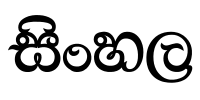Tatsama
Tatsama (Sanskrit; IPA: [tətsəmə]) are Sanskrit loanwords in modern Indo-Aryan languages like Bengali, Marathi, Oriya, Hindi, Gujarati, Sinhala and Dravidian languages like Malayalam, Kannada, Telugu, and Tamil. They belong to a higher and more erudite register than common words, many of which are (in modern Indo-Aryan languages) directly inherited from Old Indo-Aryan (tadbhava). The tatsama register can be compared to the use of words of Greek origin in English (e.g. hubris).
Bengali
The origin of tatsamas (Bengali: tôtsômô) in Bengali is traced to tenth century Brahmin poets, who felt that the colloquial language was not suitable for their expressive needs. Another wave of tatsamas entered the then Bengali language by Sanskrit scholars teaching at Fort William College in Kolkata at the start of the 19th century. The textbooks used in these courses paved the way for more tatsamas words entering common usage.
Bengali's lexicon is about 40% tatsama.[1] Writers such as Rabindranath Tagore, Michael Madhusudan Dutt, Ramram Basu, Ishwar Chandra Vidyasagar, and Bankim Chandra Chattopadhyay introduced a large number of tatsamas into Bengali.
Tatsamas in Bengali that retain their Sanskrit pronunciation are called সমোচ্চারিত shômochcharitô, while those with a differing pronunciation are called অসমোচ্চারিত ôshômochcharitô.
Oriya
Oriya is a classical language and having very strong word power nearly 185000 words recorded in Oriya Dictionary. Those words are divided into native words (Desaja) and borrowed from Sanskrit (Tatasam) and adapted with little modification from Sanskrit (Tatbhaba). The early dictionary Gitabhidhana (17th Century) by Upendra Bhanja, Sabda Tattva Abhidhana (1916) by Gopinath Nanda, Purnachandra Oriya Bhashakosha (1931) by GC Praharaj contenting 185000 words and Promoda Abhidan (1942) containing 150000 words by PC Deb and Damodara Mishar classified the Oriya words into Desaja, Tatsama and Tadbhava.
Those Oriya words are derived from Sanskrit verbal root with addition of suffixes and are used in Oriya language; these words are called ”TATSAMA KRUDANTA” words. Example Darshana is derived from drush dhatu in Sanskrit; Patha is derived from path dhatu.
Jagannath : meaning Lord of universe a Sanskrit word but used in Oriya with same meaning.[2][3]
Sinhala
The way the tatsama entered the Sinhala language is comparable to what is found in Bengali language: they are scholarly borrowings of Sanskrit or Pali terms. Tatsama in Sinhala can be identified by their ending exclusively in -ya or -va, whereas native Sinhala words tend to show a greater array of endings. Many scientific concepts make use of tatsama, for instance grahaņaya 'eclipse', but they are also found for more everyday concepts.
Telugu
Sanskrit influenced the Telugu language for about 500 years. During 1000-1100 AD, Nannaya's Telugu in Mahabharata, Telugu in several inscriptions, Telugu in poetry reestablished its roots and dominated over the royal language, Sanskrit. Telugu absorbed the Tatsamas from Sanskrit.[4]
Telugu is composed of approximately sixty percent Tatsama and Tadbhava words with origin in Sanskrit.
Metrical poetry in Telugu ('Chandassu') uses meters such as Utpalamala, Champakamala, Mattebham, Sardoola, Sragdhara, Bhujangaprayata etc.. which are pure Sanskrit meters.
Telugu has many Tatsama words. They are called Prakriti which are equivalent to Sanskrit words. The equivalent colloquial words are called Vikrutis. Vikruti means distorted. However Prakriti is only used as medium of instruction in educational institutions, offices etc. Today, the spoken Telugu contains both Prakruthi & Vikruthi words with Prakruthi words replacing Vikruthi words following years.
For example:
- Bhōjanam is Prakriti (the noun form of food) and Bōnam for Vikruti.
- Vidya (Education) is Prakriti and Viddhe is Vikriti.
- Rākshasi (Female demon) is Prakriti and Rākāsi/Rakkasi is Vikriti.
- Drishti (sight) is Prakriti and Dishti is Vikriti
- Shūnya (zero) is Prakriti and Sunnā is Vikriti
References
- ↑ Dash, Niladri S. (2015). A Descriptive Study of Bengali Words. Foreign Language Study. p. 255. Retrieved 9 December 2015.
- ↑ http://ijee.org/yahoo_site_admin/assets/docs/Dr_AK_Behra.273114506.pdf
- ↑ http://books.google.dk/books?id=Kwqc7xso22wC&pg=PA2515&lpg=PA2515
- ↑ Ramadasu, G (1980), Telugu bhasha charitra, Telugu academy
